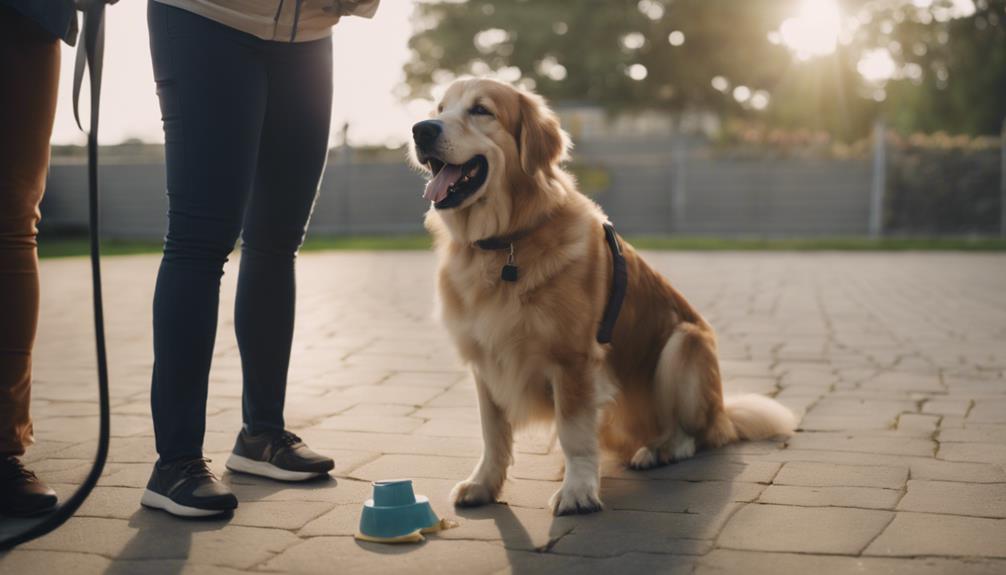Mastering the skill of potty training an older dog requires a blend of patience, strategy, and consistency. As pet owners navigate this essential aspect of canine care, a seasoned dog trainer offers a structured approach in five key steps.
From creating the right training environment to implementing a routine that fosters positive habits, each step plays a pivotal role in shaping a dog's behavior. By understanding the importance of reinforcement and monitoring progress, owners can lay the groundwork for successful potty training.
The journey towards a harmonious living space with a well-trained pet begins with these fundamental principles.
Key Takeaways
- Establish a consistent routine and designated potty area for your older dog.
- Use positive reinforcement, praise, and treats to encourage successful potty breaks.
- Maintain patience, consistency, and a reward system throughout the training process.
- Monitor progress, adjust methods as needed, and celebrate achievements in potty training your older dog.
Preparation for Potty Training
To prepare for potty training an older dog, establishing a consistent routine and designated toileting area are crucial foundational steps.
Consistency is key in helping your dog understand where and when they should eliminate. Start by setting a routine for feeding times, bathroom breaks, and walks.
Designate a specific area outside for toileting to help your dog associate that spot with the act. This designated area should be easily accessible and free from distractions.
Establishing a Toilet Training Routine
Establishing a consistent toilet training routine is essential in guiding an older dog towards successful potty training. Consistency helps to reinforce good habits and teaches the dog where and when it should eliminate. Here is a table highlighting key points for establishing a toilet training routine:
| Routine Point | Description | Importance |
|---|---|---|
| Set specific potty times | Take the dog out at regular intervals throughout the day | Helps regulate the dog's bathroom schedule |
| Use a designated toileting area | Designate a specific spot for your dog to eliminate | Helps the dog recognize where it should go |
| Reward successful potty breaks | Praise and reward the dog for using the correct spot | Reinforces positive behavior and encourages repetition |
Patience and Positive Reinforcement

Building upon the foundation of establishing a consistent toilet training routine, practicing patience and utilizing positive reinforcement are crucial elements in effectively potty training an older dog.
Patience is key when waiting for your dog to eliminate, as this process can take time. It's important to remain calm and avoid rushing the dog. Calmly praising and offering treats for successful potty breaks reinforces good behavior.
Positive reinforcement can also involve rewarding your dog with activities they enjoy, creating a positive association with the designated potty area. By combining patience with positive reinforcement, you can encourage your older dog to consistently follow the toilet training routine and achieve successful results in their potty training journey.
Consistency and Reward System
Maintaining a consistent approach and implementing a structured reward system are pivotal components in the effective potty training of an older dog.
Consistency involves taking your dog to the designated potty area at regular intervals, following a routine, and ensuring that all family members are on the same page regarding training methods. By establishing a predictable schedule, your dog will learn where and when they are expected to eliminate.
Additionally, a reward system is essential for reinforcing positive behavior. After successful potty breaks, offer immediate praise, treats, or a favorite activity to create a positive association with using the designated potty area. Consistent reinforcement of desired behavior will help your older dog understand and adhere to the potty training routine more effectively.
Progress Monitoring and Completion
Tracking the progress of your older dog's potty training and determining completion milestones are crucial steps in ensuring successful toilet training. By monitoring your dog's development, you can adjust your training methods accordingly and celebrate achievements along the way. Here is a table to help you track your dog's progress:
| Milestone | Description |
|---|---|
| Consistent Outdoor Breaks | Dog successfully eliminates outside consistently |
| Reduced Accidents | Decrease in indoor accidents over time |
| Signal for Potty | Dog indicates when it needs to go out |
Conclusion
In conclusion, the process of potty training an older dog requires careful preparation, consistency, and patience.
By following a structured routine, implementing positive reinforcement, and monitoring progress, dog owners can successfully guide their furry companions towards developing proper toilet habits.
Through dedication and a commitment to creating a conducive learning environment, pet owners can ultimately achieve a harmonious and hygienic living space for their beloved dogs.




